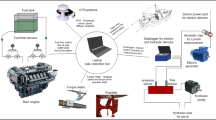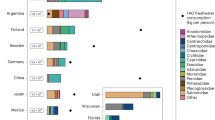Abstract
Food production is responsible for a quarter of anthropogenic greenhouse gas (GHG) emissions globally. Marine fisheries are typically excluded from global assessments of GHGs or are generalized based on a limited number of case studies. Here we quantify fuel inputs and GHG emissions for the global fishing fleet from 1990–2011 and compare emissions from fisheries to those from agriculture and livestock production. We estimate that fisheries consumed 40 billion litres of fuel in 2011 and generated a total of 179 million tonnes of CO2-equivalent GHGs (4% of global food production). Emissions from the global fishing industry grew by 28% between 1990 and 2011, with little coinciding increase in production (average emissions per tonne landed grew by 21%). Growth in emissions was driven primarily by increased harvests from fuel-intensive crustacean fisheries. The environmental benefit of low-carbon fisheries could be further realized if a greater proportion of landings were directed to human consumption rather than industrial uses.
This is a preview of subscription content, access via your institution
Access options
Access Nature and 54 other Nature Portfolio journals
Get Nature+, our best-value online-access subscription
$29.99 / 30 days
cancel any time
Subscribe to this journal
Receive 12 print issues and online access
$209.00 per year
only $17.42 per issue
Buy this article
- Purchase on SpringerLink
- Instant access to full article PDF
Prices may be subject to local taxes which are calculated during checkout



Similar content being viewed by others
References
Smith, P. et al. in Climate Change 2014: Mitigation of Climate Change (eds Edenhofer, O. et al.) (Cambridge Univ. Press, Cambridge, UK, 2014).
Steinfeld, H. et al. Livestock’s Long Shadow: Environmental Issues and Options (FAO, Rome, Italy, 2006).
Webb, R. & Buratini, J. Global challenges for the 21st century: the role and strategy of the agri-food sector. Anim. Reprod. 13, 133–142 (2016).
Garnett, T. Livestock-related greenhouse gas emissions: impacts and options for policy makers. Environ. Sci. Policy 12, 491–503 (2009).
Pelletier, N. & Tyedmers, P. Forecasting potential global environmental costs of livestock production 2000–2050. Proc. Natl Acad. Sci. USA 107, 18371–18374 (2010).
Herrero, M. et al. Greenhouse gas mitigation potentials in the livestock sector. Nat. Clim. Change 6, 452–461 (2016).
Fiala, N. Meeting the demand: an estimation of potential future greenhouse gas emissions from meat production. Ecol. Econ. 67, 412–419 (2008).
Popp, A. Food consumption, diet shifts and associated non-CO2 greenhouse gases from agricultural production. Glob. Environ. Change 20, 451–462 (2010).
Tilman, D. & Clark, M. Global diets link environmental sustainability and human health. Nature 515, 518–522 (2014).
Carlsson-Kanyama, A. Climate change and dietary choices — how can emissions of greenhouse gases from food consumption be reduced? Food Policy 23, 277–293 (1998).
Nilsson, K. & Sonesson, U. Changing Diets – What is the Influence on Greenhouse Gas (GHG) Emissions of Different Consumption Patterns? (LCA Food, 2010); http://eventi.ict.uniba.it/lcafood2010/presentations/thursday-23/parallel-3b/Nilsson.pdf
UNFCCC. Adoption of the Paris Agreement Report No. FCCC/Co/2015/L9/Rev.1 (UNFCCC, 2015).
Rogelj, J. et al. Paris Agreement climate proposals need a boost to keep warming well below 2°C. Nature 534, 632–639 (2016).
Pelletier, N. et al Energy intensity of agriculture and food systems. Annu. Rev. Environ. Resour. 36, 223–246 (2011).
Nijdam, D., Rood, T. & Westhoek, H. The price of protein: review of land use and carbon footprints from life cycle assessments of animal food products and their substitutes. Food Policy 37, 760–770 (2012).
Foley, J. A. et al. Solutions for a cultivated planet. Nature 478, 337–342 (2011).
FAOSTAT Emissions Database (FAO, 2013); http://faostat.fao.org/
González, D. et al. Protein efficiency per unit energy and per unit greenhouse gas emissions: potential contribution of diet choices to climate change mitigation. Food Policy 36, 562–570 (2011).
Parker, R. & Tyedmers, P. Fuel consumption of global fishing fleets: current understanding and knowledge gaps. Fish Fish. 16, 684–696 (2015).
Tyedmers, P. in Encyclopedia of Energy Vol. 1 (ed. Cleveland, C.) 683–693 (Elsevier, New York, USA, 2004).
Tyedmers, P., Watson, R. & Pauly, D. Fueling global fishing fleets. Ambio 34, 635–638 (2005).
Cheung, W., Watson, R. & Pauly, D. Signature of ocean warming in global fisheries catch. Nature 497, 365–369 (2013).
Abernethy, K. E., Trebilcock, P., Kebede, B., Allison, E. H. & Dulvy, N. K. Fuelling the decline in UK fishing communities? ICES J. Mar. Sci. 67, 1076–1085 (2010).
Pelletier, N. et al. Energy prices and seafood security. Glob. Environ. Change 24, 30–41 (2014).
Fulton, S. Fish and Fuel: Life Cycle Greenhouse Gas Emissions associated with Icelandic cod, Alaskan pollock, and Alaskan Pink Salmon Fillets delivered to the United Kingdom. MES thesis, Dalhousie Univ. (2010).
FAO. The State of World Fisheries and Aquaculture 2012 (FAO, 2013).
Deutsch, L. et al. Feeding aquaculture growth through globalization: exploitation of marine ecosystems for fishmeal. Glob. Environ. Change 17, 238–249 (2007).
Watson, R. A. et al. Marine foods sourced from farther as their use of global ocean primary production increases. Nat. Commun. 6, 7365 (2015).
Fish Meal Production by Country in 1000 MT (USDA, 2014); http://www.indexmundi.com/agriculture/?commodity=fish-meal
Tacon, A. G. J. & Metian, M. Global overview on the use of fish meal and fish oil in industrially compounded aquafeeds: trends and future prospects. Aquaculture 285, 146–158 (2008).
FAO Yearbook. Fishery and Aquaculture Statistics 2012 (FAO, 2014); ftp://ftp.fao.org/FI/CDrom/CD_yearbook_2012/index.htm
Boopendranath, M. R. & Hameed, M. S. Gross energy requirement in fishing operations. Fish. Technol. 50, 27–35 (2013).
Lam, V. W. Y., Sumaila, U. R., Dyck, A., Pauly, D. & Watson, R. Construction and first applications of a global cost of fishing database. ICES J. Mar. Sci. 68, 1996–2004 (2011).
Cheilari, A., Guillen, J., Damalas, D. & Barbas, T. Effects of the fuel price crisis on the energy efficiency and the economic performance of the European Union fishing fleets. Mar. Policy 40, 18–24 (2013).
Guillen, J., Cheilari, A., Damalas, D. & Barbas, T. Oil for fish: an energy return on investment analysis of selected European Union fishing fleets. J. Ind. Ecol. 20, 145–153 (2016).
Tyedmers, P. in Fisheries Impacts on North Atlantic Ecosystems: Catch, Effort, and National/Regional Datasets. Fisheries Centre Research Reports 9 (eds Zeller, D. et al.) 12–34 (Univ. British Columbia, Vancouver, Canada, 2001).
Parker, R., Hartmann, K., Green, B., Gardner, C. & Watson, R. Environmental and economic dimensions of fuel use in Australian fisheries. J. Clean. Prod. 87, 78–86 (2015).
Parker, R. Implications of high animal by-product feed inputs in life cycle assessments of farmed Atlantic salmon. Int. J. Life Cycle Assess. https://doi.org/10.1007/s11367-017-1340-9 (2017).
Ziegler, F. & Hornborg, S. Stock size matters more than vessel size: the fuel efficiency of Swedish demersal trawl fisheries 2002–2010. Mar. Policy 44, 72–81 (2014).
Thrane, M. Energy consumption in the Danish fishery: identification of key factors. J. Ind. Ecol. 8, 223–239 (2004).
Ruttan, L. M. & Tyedmers, P. H. Skippers, spotters and seiners: analysis of the “skipper effect” in US menhaden (Brevoortia spp.) purse-seine fisheries. Fish. Res. 83, 73–80 (2007).
Vázquez-Rowe, I. & Tyedmers, P. Identifying the importance of the “skipper effect” within sources of measured inefficiency in fisheries through data envelopment analysis (DEA). Mar. Policy 38, 387–396 (2013).
Pascoe, S., Coglan, L., Punt, A. E. & Dichmont, C. M. Impacts of vessel capacity reduction programmes on efficiency in fisheries: the case of Australia’s multispecies northern prawn fishery. J. Agric. Econ. 63, 425–443 (2012).
Hua, J. & Wu, Y. H. Implications of energy use for fishing fleet—Taiwan example. Energy Policy 39, 2656–2668 (2011).
Green Growth and Energy Use in Fisheries and Aquaculture (Organization for Economic Cooperation and Development, 2012).
Driscoll, J. & Tyedmers, P. Fuel use and greenhouse gas emission implications of fisheries management: the case of the New England Atlantic herring fishery. Mar. Policy 34, 353–359 (2010).
Swartz, W., Sumaila, U. R., Watson, R. & Pauly, D. Sourcing seafood for the three major markets: the EU, Japan and the USA. Mar. Policy 34, 1366–1373 (2010).
Watson R. A., Nichols, R., Lam, V. W. Y. & Sumaila, U. R. Global seafood trade flows and developing economies: insights from linking trade and production. Mar. Policy 82, 41–49 (2017).
Ziegler, F. et al. The carbon footprint of Norwegian seafood products on the global seafood market. J. Ind. Ecol. 17, 103–116 (2013).
Watson, R. A. et al. Mapping global fisheries: sharpening our focus. Fish Fish. 5, 168–177 (2004).
Watson, R. A. A database of global marine commercial, small-scale, illegal and unreported fisheries catch 1950–2014. Sci. Data 4, 170039 (2017).
Corbett, J. & Winebrake, J. Emissions tradeoffs among alternative marine fuels: total fuel cycle analysis of residual oil, marine gas oil, and marine diesel oil. J. Air Waste Manag. Assoc. 58, 538–542 (2008).
Weidema, B. P. et al. The Ecoinvent Database: Overview and Methodology, Data Quality Guideline for the Ecoinvent Database Version 3 (Ecoinvent, 2013); http://www.ecoinvent.org
Avadí, A. & Fréon, P. Life cycle assessment of fisheries: a review for fisheries scientists and managers. Fish. Res. 143, 21–38 (2013).
Parker, R. Review of Life Cycle Assessment Research on Products derived from Fisheries and Aquaculture (Sea Fish Industry Authority, Edinburgh, UK, 2012).
Vázquez-Rowe, I., Hospido, A., Moreira, M. T. & Feijoo, G. Best practices in life cycle assessment implementation in fisheries. Improving and broadening environmental assessment for seafood production systems. Trends Food Sci. Tech. 28, 116–131 (2012).
Vázquez-Rowe, I., Moreira, M. T. & Feijoo, G. Life cycle assessment of horse mackerel fisheries in Galicia (NW Spain): comparative analysis of two major fishing methods. Fish. Res. 106, 517–527 (2010).
Vivekanandan, E., Singh, V. V. & Kizhakudan, J. K. Carbon footprint by marine fishing boats of India. Curr. Sci. 105, 361–366 (2013).
Port, D., Alvarez Perez, J. A. & Thadeu de Menezes, J. Energy direct inputs and greenhouse gas emissions of the main industrial trawl fishery of Brazil. Mar. Pollut. Bull. 107, 251–260 (2016).
Driscoll, J., Boyd, C. & Tyedmers, P. Life cycle assessment of the Maine and southwest Nova Scotia lobster industries. Fish. Res. 172, 385–400 (2015).
Acknowledgements
Research funding was provided by the Australian Seafood Cooperative Research Centre (Project 100596). R.W.R.P. acknowledges support from the Natural Sciences and Engineering Research Council of Canada (PDF-487958-2016). R.A.W. acknowledges support from the Australian Research Council (Discovery project DP140101377).
Author information
Authors and Affiliations
Contributions
R.W.R.P. co-manages FEUD, conducted analyses and wrote the manuscript. J.L.B., C.G. and B.S.G. assisted with projected development and manuscript preparation. K.H. assisted with data analysis and manuscript preparation. P.H.T. developed and co-manages FEUD and assisted with manuscript preparation. R.A.W. provided global fishery landing data and assisted with data analysis and manuscript preparation.
Corresponding author
Ethics declarations
Competing interests
The authors declare no competing interests.
Additional information
Publisher’s note: Springer Nature remains neutral with regard to jurisdictional claims in published maps and institutional affiliations.
Rights and permissions
About this article
Cite this article
Parker, R.W.R., Blanchard, J.L., Gardner, C. et al. Fuel use and greenhouse gas emissions of world fisheries. Nature Clim Change 8, 333–337 (2018). https://doi.org/10.1038/s41558-018-0117-x
Received:
Accepted:
Published:
Issue Date:
DOI: https://doi.org/10.1038/s41558-018-0117-x



